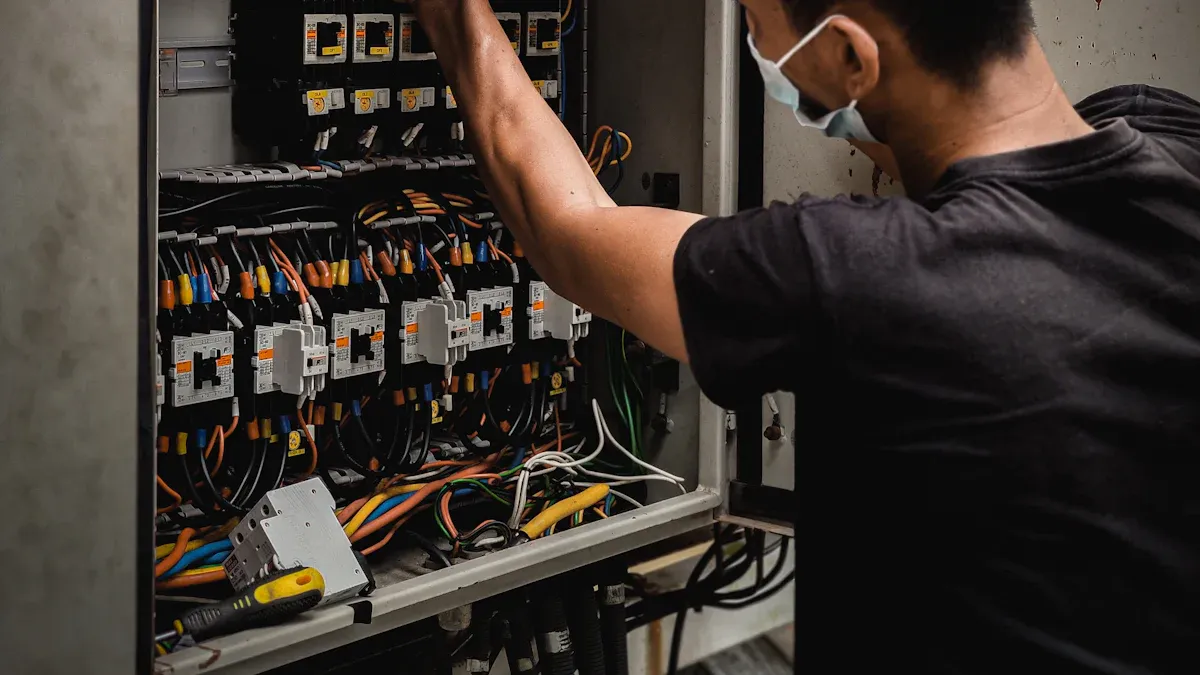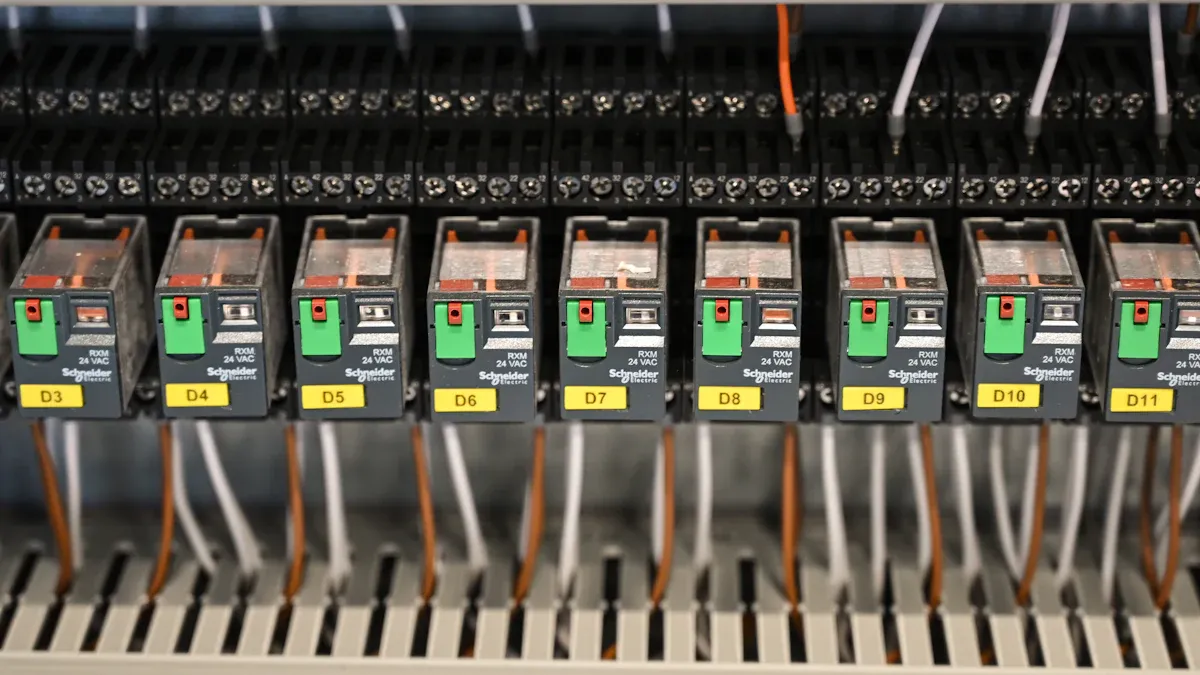What Is a Rectifier Power Supply by ESTEL and How Does It Work

A rectifier power supply transforms alternating current (AC) into direct current (DC) power, ensuring stable and reliable energy for your devices. This conversion plays a vital role in industries where precision and efficiency matter most. For example, the growing use of electric motors and renewable energy sources has amplified the need for advanced rectifier technologies. These systems improve operational performance while reducing environmental impact.
ESTEL stands out as a trusted provider of rectifier power supplies. Their solutions combine efficiency, durability, and adaptability to meet your power needs across industrial, telecommunication, and consumer applications.
Key Takeaways
A rectifier power supply changes AC power into steady DC power. This is important for machines and telecom equipment to work properly.
It has parts like transformers, rectifiers, filters, and voltage regulators. Each part helps give steady and reliable power.
Filters remove small bumps in the DC power, making it smooth. This keeps delicate devices safe and working well.
Voltage regulators keep the output voltage steady. This helps devices work fine even if input power changes.
Picking a good rectifier power supply improves efficiency and reliability. It is important for many different uses.
How a Rectifier Power Supply Works

AC to DC Conversion Process
The primary function of a rectifier power supply is to convert alternating current (AC) into direct current (DC). This process begins with the AC input, which alternates its direction periodically. A rectifier takes this input and transforms it into a unidirectional DC output. This conversion is crucial for devices that rely on stable DC power, such as telecommunications equipment and industrial machinery.
The AC to DC conversion involves several key components working together:
Transformers step down the high AC voltage to a lower level suitable for rectification.
Rectifiers, such as single-phase half-wave rectifiers and full-wave rectifiers, convert the AC into pulsating DC.
Filters smooth out the pulsating DC to create a more stable voltage.
Voltage regulators ensure the output voltage remains constant, even when the load conditions vary.
For instance, a half-wave rectifier converts the AC voltage into a pulsating DC voltage by allowing only one half of the AC waveform to pass through. However, this pulsating output is not ideal for most electronic devices, which require a smoother DC voltage. This is where the next step, filtering, becomes essential.
Filtering for Smooth DC Output
After rectification, the DC output still contains ripples or fluctuations. These ripples can interfere with the performance of sensitive electronic devices. To address this, the rectifier power supply uses filters to smooth the output.
Filters typically consist of components like capacitors or a combination of capacitors and inductors. A capacitor, for example, stores electrical energy and releases it gradually, filling in the gaps in the pulsating DC waveform. This process results in a more consistent and stable DC power output.
Imagine a half-wave rectifier paired with a simple electrolytic capacitor. The capacitor charges during the peaks of the pulsating DC and discharges during the troughs, effectively reducing the ripple effect. This ensures that the DC power supply delivers a smoother and more reliable voltage to your devices.
Voltage Regulation in a Regulated Power Supply
Even with filtering, the output voltage can fluctuate due to changes in load or input voltage. A regulated power supply addresses this issue by incorporating a voltage regulator. This component maintains a constant output voltage, ensuring your devices receive the precise power they need to operate efficiently.
Voltage regulators work by comparing the output voltage to a reference voltage. If the output deviates, the regulator adjusts it by either increasing or decreasing the current flow. This dynamic adjustment ensures that the rectifier power supply delivers consistent and reliable DC power, regardless of external conditions.
For example, in a telecommunications system, a regulated power supply ensures that sensitive equipment operates without interruptions, even during power surges or drops. This reliability makes regulated power supplies indispensable in applications where precision and stability are critical.
Components of a Rectifier Power Supply
Understanding the components of a rectifier power supply helps you appreciate how these systems deliver stable and efficient DC power. Each part plays a critical role in ensuring the conversion process is smooth and reliable.
Role of the Transformer
The transformer is the first component in a rectifier power supply. It adjusts the AC voltage to a level suitable for rectification. If the input voltage is too high, the transformer steps it down. Conversely, it can step up the voltage when needed. This ensures the rectifier receives the correct voltage for conversion.
According to the International Energy Agency (IEA), about 65% of industrial DC power systems rely on rectifier transformers for effective power conversion. This highlights their importance in global energy systems. Without a transformer, your power supply unit would struggle to match the voltage requirements of your devices.
Transformers also provide electrical isolation between the input and output circuits. This isolation protects your devices from potential surges or faults in the AC supply. For example, in a half-wave rectifier, the transformer ensures the AC voltage is reduced to a safer level before the rectification process begins.
Function of the Rectifier
The rectifier is the heart of the system. It converts AC into DC by allowing current to flow in only one direction. This is achieved using diodes, which act as one-way gates for electrical current.
In a half-wave rectifier, a single diode blocks the negative half of the AC waveform, producing a pulsating DC output. While this method is simple, it is less efficient because it uses only half of the AC cycle. Full-wave rectifiers, on the other hand, use multiple diodes to convert both halves of the AC waveform into DC, resulting in higher efficiency.
Recent advancements in rectifier technology have improved efficiency and durability. Active rectification, which replaces traditional diodes with controlled switches like MOSFETs, eliminates the fixed voltage drop associated with diodes. This innovation enhances the performance of modern power supply systems, making them more reliable and energy-efficient.
Rectifiers are essential in applications ranging from telecommunications to industrial machinery. They ensure your devices receive the steady DC power they need to operate effectively.
Importance of the Filter
After rectification, the DC output still contains ripples, which can disrupt sensitive electronic devices. Filters smooth out these fluctuations, providing a stable DC voltage.
Filters typically use capacitors to store and release electrical energy. For instance, in a half-wave rectifier, a reservoir capacitor charges during the peaks of the pulsating DC and discharges during the troughs. This process reduces voltage ripple and ensures a smoother output.
Empirical data from a 150 kW inverter prototype demonstrates the effectiveness of filters in minimizing voltage ripple. The study shows that calculated ripple values closely match experimental results, confirming the reliability of filters in rectifier systems.
Filters are indispensable in applications requiring precision, such as medical equipment and telecommunications. They ensure your devices operate without interruptions, even under varying load conditions.
Voltage Regulator in Power Supply Systems
A voltage regulator is a critical component in any rectifier power supply. It ensures that the output voltage remains constant, even when the input voltage or load conditions change. Without this stability, your devices could experience performance issues or even damage.
Voltage regulators work by comparing the output voltage to a fixed reference voltage. If the output deviates, the regulator adjusts the current flow to bring it back to the desired level. This dynamic adjustment guarantees that your devices receive the precise voltage they need to function efficiently.
There are two main types of voltage regulators: linear and switching. Linear regulators are simple and provide a clean, noise-free output. However, they can waste energy as heat. Switching regulators, on the other hand, are more efficient and suitable for high-power applications. They use components like transistors and diodes to control the voltage.
Imagine you are using a half-wave rectifier to power a sensitive electronic device. The rectifier converts AC to DC, but the output may still fluctuate due to changes in the input voltage. A voltage regulator steps in to smooth out these fluctuations. It ensures that your device receives a steady and reliable power supply, regardless of external conditions.
In a regulated power supply, the voltage regulator works alongside other components like the transformer, rectifier, and filter. For example, after the half-wave rectifier produces a pulsating DC output, the filter reduces the ripples. The voltage regulator then fine-tunes the output to maintain a constant voltage. This multi-step process ensures that your devices operate safely and efficiently.
Voltage regulators are indispensable in applications where precision and stability are essential. Whether you are powering telecommunications equipment, industrial machinery, or consumer electronics, a reliable voltage regulator ensures optimal performance. By maintaining a consistent output, it protects your devices from voltage spikes and drops, extending their lifespan.
Tip: When choosing a rectifier power supply, always consider the type of voltage regulator it uses. A high-quality regulator can make a significant difference in the performance and durability of your devices.
Applications of Rectifier Power Supplies

Use in Industrial Equipment
Rectifier power supplies play a vital role in industrial equipment by ensuring stable and efficient DC power for machinery and automation systems. You’ll find these systems in industries like manufacturing, automotive, and renewable energy. Their ability to convert AC power into reliable DC power makes them indispensable for powering motors, robotics, and control systems.
The growing demand for rectifier modules in industrial automation highlights their importance. These modules are widely used in robotics and machinery, where precision and reliability are critical. The transition to electric and hybrid vehicles has further increased the need for rectifiers in automotive power management systems. Additionally, renewable energy sectors rely on rectifier power supplies to convert variable AC power from sources like wind turbines into consistent DC power for storage and distribution.
The rectifier module market is expanding rapidly due to its applications in:
Renewable energy systems.
Automotive power management.
Industrial automation and robotics.
By integrating rectifier power supplies into your industrial equipment, you can enhance operational efficiency and reduce downtime, ensuring your systems perform optimally.
Role in Telecommunications
Telecommunications systems depend on rectifier power supplies to maintain uninterrupted service. These systems convert AC power into DC power to support sensitive equipment like servers, routers, and signal transmitters. You’ll notice their importance during power outages, as they seamlessly switch to battery power to prevent service interruptions.
Embedded rectifier power supply systems monitor critical parameters to ensure operational integrity. For example, when mains power fails, the system transitions to battery power while triggering alarms to alert operators of voltage drops. This proactive approach minimizes downtime and ensures consistent service quality.
Key features of rectifier power supplies in telecommunications include:
Maintenance-free batteries for reliability.
Modular rectifier systems for scalability.
Predictive maintenance techniques to optimize costs.
By leveraging these systems, you can ensure your telecommunications network remains reliable, even under challenging conditions.
Application in Consumer Electronics
Rectifier power supplies are essential in consumer electronics, providing energy-efficient solutions for devices like laptops, smartphones, and small appliances. These systems convert AC power into DC power, enabling your devices to operate smoothly and efficiently.
High-frequency rectification technologies are increasingly adopted in portable electronics to enhance energy efficiency and performance. For example, laptops and smartphones use advanced rectifiers to minimize energy loss and extend battery life. The demand for energy-efficient solutions is driving significant growth in the rectifier market, with applications ranging from low-power devices to small household appliances.
Segment | Market Share (%) | Application Area |
|---|---|---|
0.5 - 3.0 Amps | 55.46 | Low-power applications |
Consumer electronics | ||
Small appliances |
By incorporating rectifier power supplies into your consumer electronics, you can enjoy improved energy efficiency and device performance, making them a valuable addition to modern technology.
Advantages of Rectifier Power Supplies
Efficiency in Power Conversion
Rectifier power supplies excel in power conversion, ensuring your devices receive stable and efficient dc power. Full bridge rectifiers, for instance, utilize both halves of the AC waveform, producing higher DC output voltage compared to half-wave rectifiers. They simplify design by eliminating the need for a center-tap transformer, reducing costs while maintaining performance.
Key advantages of full bridge rectifiers include:
Smoother DC output with lower ripple factor, ideal for sensitive devices.
Lower Peak Inverse Voltage (PIV) requirements for diodes, enabling cost-effective components.
Performance metrics further highlight the efficiency of rectifier systems:
Metric | Description | Impact on Efficiency |
|---|---|---|
Power Factor | Ratio of real power to apparent power. | Higher power factor reduces energy costs and losses. |
Total Harmonic Distortion | Measures deviation from ideal sinusoidal output. | Lower THD leads to cleaner output and improved efficiency. |
Ripple Voltage | Variation in DC output voltage after rectification. | Lower ripple ensures stable output, enhancing performance. |
Load Regulation | Ability to maintain constant output voltage despite load changes. | Good regulation protects devices from voltage fluctuations. |
Line Regulation | Ability to maintain constant output voltage despite input voltage changes. | Ensures reliable power supply in unstable environments. |
Reliability and Durability
Rectifier power supplies offer unmatched reliability and durability, ensuring your systems operate without interruptions. MTBF (Mean Time Between Failures) serves as a key reliability metric, influenced by factors such as design quality, component aging, and environmental conditions.
Reliability statistics emphasize the importance of robust design:
High-quality components withstand operational stress and electromagnetic interference.
Redundancy features enhance durability, reducing the risk of failure.
Proper maintenance practices extend the lifespan of your dc power supply.
By choosing a rectifier power supply with a high MTBF, you ensure consistent performance and minimize downtime for your devices.
Adaptability to Voltage Requirements
Rectifier power supplies adapt seamlessly to varying voltage needs, making them versatile for diverse applications. Modular systems allow you to customize setups based on specific voltage and current ranges. Scalability ensures your power supply remains relevant as operational demands evolve.
Technical features that enhance adaptability include:
Feature | Description |
|---|---|
Scalability | Add more units or reconfigure setups to meet changing needs. |
Customization to Specific Needs | Tailor systems to specific voltage, current ranges, or special features. |
Series Configuration | Increase voltage capacity while maintaining current, ideal for high voltage applications. |
Parallel Configuration | Increase current capacity while keeping voltage constant, suitable for high current needs. |
These features ensure your rectifier power supply delivers reliable dc power, whether for industrial equipment, telecommunications, or consumer electronics.
A rectifier power supply is essential for converting AC into stable DC power, ensuring your devices operate efficiently. Its components, including the rectifier, transformer, filter, and voltage regulator, work together to deliver reliable power. These systems are vital across industries, from telecommunications to consumer electronics, where precision and stability are critical.
Different rectifier types offer varying levels of efficiency and application suitability:
Rectifier Type | Description | Efficiency | Applications |
|---|---|---|---|
Half-wave | Uses a single diode, converts half of the AC wave, higher ripple, less efficient. | Low | Low-importance devices |
Full-wave | Requires a center tap, more efficient, produces less ripple. | Medium | General applications |
Bridge | Uses four diodes, most efficient, converts full AC wave without a center tap. | High | High-performance applications |
When you choose ESTEL, you gain access to high-quality rectifier power supplies designed for efficiency and durability. Their expertise ensures your systems receive the stable DC power they need to perform at their best.
FAQ
What is the purpose of a rectifier power supply?
A rectifier power supply converts alternating current (AC) into direct current (DC). It provides stable DC power for devices like industrial equipment, telecommunications systems, and consumer electronics. This ensures your devices operate efficiently and reliably.
How does a rectifier differ from a transformer?
A rectifier converts AC to DC, while a transformer adjusts the voltage level of AC. Both components work together in a rectifier power supply to deliver the correct and stable DC voltage required by your devices.
Can a rectifier power supply handle voltage fluctuations?
Yes, it can. Voltage regulators within the system maintain a constant output voltage, even when input voltage or load conditions change. This ensures your devices receive consistent power without interruptions.
Where are rectifier power supplies commonly used?
You’ll find them in industries like telecommunications, manufacturing, and consumer electronics. They power devices such as routers, industrial machinery, and portable electronics by providing reliable DC power.
How do filters improve the performance of a rectifier power supply?
Filters smooth out ripples in the DC output after rectification. This creates a stable voltage, which is essential for sensitive devices like medical equipment and telecommunications systems.
See Also
Understanding the Power System of ESTEL Telecom Cabinets
Ensuring Correct Voltage Levels in ESTEL Communication Cabinets
Telecom Cabinets by ESTEL: The Role of Energy Storage
CALL US DIRECTLY
86-13752765943
3A-8, SHUIWAN 1979 SQUARE (PHASE II), NO.111, TAIZI ROAD,SHUIWAN COMMUNITY, ZHAOSHANG STREET, NANSHAN DISTRICT, SHENZHEN, GUANGDONG, CHINA


